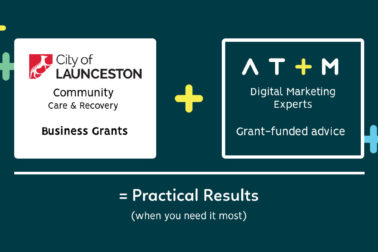What does a successful marketing strategy look like?
Defining success goes beyond metrics and buzzwords.
A successful marketing strategy is a bit like a map from where a brand is, to where it wants to go. Choosing the right KPIs allows you to measure success on the way to the end goal.
While it may sound simple, it’s easy for businesses to lose sight of what actually contributes to marketing success and start chasing vanity metrics and blindly follow industry fads.
“Half the money I spend on advertising is wasted; the trouble is I don’t know which half.”
John Wannamaker

Join us as we explore the ins and outs of meaningful success through different examples of a digital marketing strategy.
What does successful branding look like?
What it isn’t:
Successful branding means much more than a nice new logo. It isn’t just about:
- Pretty pictures
While visual appeal is important, it doesn’t necessarily translate into branding success.
- Mimicking competitor’s strategies
Copying competitors may attract short-term attention, but it fails to establish a unique identity and build genuine connections with customers.
What it is:
Successful branding is a blend of:
- Strategic positioning
Carving out a distinct niche in the market and highlighting your unique selling proposition (USP). Effectively communicating the USP differentiates your brand and places it in a clear space in your target customer’s mind. This sets your brand apart and helps to drive preference amidst competition.
“Positioning is finding the right parking space inside the consumer’s mind and going for it before someone else takes it.”
Laura Busche
- The right audience
You can’t be all things to all people – a core part of a successful brand is knowing who your customer isn’t.
- Consistency
Being consistent across all touchpoints reinforces brand identity, building trust and recognition over time.
Ultimately, successful branding is about forging meaningful relationships and conveying value that resonates deeply with your audience.
Close your eyes and imagine a hotel built by Nike. You probably have a clear picture of what it looks and feels like. This is because of the strength of Nike’s brand, formulated through years of consistent brand positioning.
“Your brand is what other people say about you when you’re not in the room.”
Jeff Bezos
Tips:
Focus on positioning your brand uniquely in the market, highlighting your USPs to stand out from competitors. Invest in storytelling and compelling content to effectively communicate your brand’s narrative and value proposition.
You need to understand and connect with your target audience on an intimate level. Your positioning strategy should resonate with their needs, desires and aspirations. Your brand should aim to create an emotional bond with your customers, by crafting copy and visual elements that resonate with their values.
Consistency is key across all brand touchpoints, ensuring a cohesive and memorable experience. From logos and colours, to tone and language style, brand consistency leads to recognition.
By embracing these strategies, you can cultivate a strong and enduring brand presence that captivates consumers and drives success.
What does a successful website look like?
What it isn’t:
Just because heaps of people are visiting your website doesn’t mean it is working successfully for your business.
While high traffic may seem promising, it’s the quality of that traffic that matters. Imagine you registered your brand-new website “gogle.com” and realised you had thousands of visitors a day who bounced after only a few seconds. Would you consider this to be a success?
What it is:
Website success starts with defining the actions you want customers to perform when they visit your website.
In the web world we call these conversion actions, and they should represent actions that contribute to the bottom-line success for your business.
Conversion actions may differ for different websites, but they usually include actions such as:
- Generating sales
- Converting leads
- Nurturing enquiries
- Encouraging signups
These conversion actions should be measured through analytics software such as Google Analytics.
But, to complicate things, a website isn’t ALL about conversion actions. It should also include:
- Consistent brand design
“Design is the silent ambassador of your brand.”
Paul Rand
- Compelling content
- Seamless user experience
In the digital world, your website might be the only place some customers interact with your brand. This makes it even more important to get all the aspects correct to successfully communicate your value proposition and build lasting customer relationships.
Tips:
To steer a website towards success,
- Define the conversions that constitute a successful website visit and track them through analytics software.
- Focus on optimising for conversions rather than just traffic.
- Tailor your content and user experience to resonate with your target audience.
- Guide visitors towards desired actions like making purchases or submitting enquiries.
- Invest in intuitive navigation and clear calls-to-action to streamline the user journey.
- Ensure consistent branding across all touchpoints to reinforce your identity and build trust with visitors.
These strategies can elevate your website’s effectiveness and drive meaningful results.

Give your audience a few simple and clear options.
What does successful social media marketing look like?
What it isn’t:
It’s a common misconception to equate success on social media with metrics like
- Follower count
- Likes
- Going “viral”
While these metrics may seem promising, they often don’t reflect genuine engagement or conversions. Prioritising pretty pictures over substance can lead to shallow interactions, that will not have a meaningful impact.
Additionally, spreading oneself too thin across every social media channel can dilute marketing efforts, as your target audience may not be active on every platform.
What it is:
Successful social media marketing transcends superficial metrics, focusing instead on fostering quality engagement and meaningful interactions with your audience. It’s about creating and growing a vibrant community that actively engages with your content and shares their experiences with others.
Moreover, it involves driving tangible outcomes such as website conversions, sales, leads, enquiries and signups.
You can cultivate a loyal following that translates into real business growth by
- Providing valuable content
- Responding promptly to enquiries
- Fostering genuine connections
Ultimately, successful social media marketing that contributes to your overall business objectives hinges on
- Building relationships
- Driving action
- Delivering measurable results
Tips:
To achieve success in social media marketing,
- Practice quality over quantity by focusing on meaningful engagement and interactions with your audience.
- Cultivate a sense of community by engaging in conversation and sharing valuable content that resonates with your followers.
- Strategically promote your website and products to drive conversions and capture leads.
- Regularly analyse performance metrics to refine your strategy and ensure alignment with your business goals.
- Choose social media platforms that fit your brand and reach your target market.
By implementing these tips, you can maximise the impact of your social media efforts and drive tangible results.
“Social media is the ultimate customer service tool. It gives brands the opportunity to listen, respond, and delight customers in real-time.”
Unknown
What does a successful eCommerce strategy look like?
What it isn’t:
It goes without saying that an eCommerce website that is not making any sales is not succeeding. But even if your website looks successful on the surface, some tactics could be hurting your long-term profitability.
If your brand is generating sales, but only due to a strategy that includes frequent discounts, it may not be successful. Frequent discount sales may devalue products and erode profit margins over time.
One-off purchases may not reliably indicate eCommerce success as they often lack the sustainability and customer loyalty necessary for long-term profitability and growth. Many eCommerce businesses rely on paid advertising to generate sales, and while this is an effective strategy, it can hurt the profit margin if customers only make one purchase. For this reason, it is important to focus not just on ROAS (return on ad spend), but on CLV (Customer Lifetime Value).
Positive reviews alone do not necessarily indicate a successful eCommerce strategy because they may not reflect the overall performance or profitability of the business, as success in eCommerce involves multiple aspects beyond customer feedback.
What it is:
A successful eCommerce strategy goes beyond short-term tactics to focus on driving consistent sales growth and maximising customer lifetime value (CLV). It involves implementing a comprehensive approach that optimises every stage of the customer journey, from acquisition to retention. This includes
- Leveraging data-driven insights to personalise marketing efforts
- Enhancing product recommendations
- Streamlining the purchasing process
Successful eCommerce strategies build strong customer relationships through exceptional service, personalised experiences, and post-purchase engagement.
By emphasising long-term value over quick wins, businesses can
- Foster loyalty
- Increase repeat purchases
- Ultimately drive sustainable revenue growth in the competitive online marketplace
Tips:
To excel in eCommerce, prioritise maximising sales and CLV by focusing on personalised customer experiences and long-term value creation.
Utilise data to understand customer behaviour and preferences, allowing for targeted marketing campaigns and product recommendations.
Provide excellent customer service to build trust and loyalty, fostering repeat purchases and positive word-of-mouth.
Additionally, streamline the checkout process and offer incentives for returning customers to enhance retention, increase conversion rates, and drive sustainable revenue growth.
What does successful SEO look like?
What it isn’t:
When it comes to Search Engine Optimisation (SEO), don’t be fooled into believing that success is solely defined by maximising website traffic. Back in the early days of the internet, many brands resorted to creating keyword-stuffed content to rank for as many searches as possible. But this just doesn’t work anymore. Relying solely on cheap tactics can backfire, as search engines increasingly prioritise quality and relevance over sheer volume – and real people can tell the difference.
While AI is a powerful tool for optimising content, overuse can result in spammy, low-quality material that ultimately harms rankings.
What it is:
Successful SEO is about more than just big numbers in your traffic reports – and should instead focus on driving qualified leads and conversions.
It involves targeting the right audience through strategic keyword selection, including long-tail keywords that capture specific user intent. Successful SEO strategies value niche targeting, tailoring content to resonate with highly relevant audiences.
By understanding user behaviour and search intent, businesses can optimise their online presence to attract engaged visitors who are more likely to convert.
Ultimately, successful SEO revolves around
- Delivering valuable content that satisfies user needs.
- Positioning websites as authoritative resources within their respective niches.
- Earning authoritative backlinks to further enhance visibility and credibility in search engine results.
Tips:
To achieve success in SEO,
- Focus on creating high-quality, relevant content that addresses the needs and interests of your target audience.
- Conduct thorough keyword research to identify long-tail keywords and niche topics that align with user intent.
- Optimise on-page elements such as titles, meta descriptions and headers to improve visibility and relevance.
- Invest in building authoritative backlinks from reputable sources within your industry to boost credibility and enhance search engine rankings.

Defining Success
It’s easy to get caught up in superficial metrics and trendy tactics, losing sight of what truly drives success in marketing. While flashy numbers and quick fixes may offer temporary satisfaction, they often fail to deliver sustainable results.
It’s crucial to stay focused on what will get you results: understanding your audience, delivering value and driving tangible outcomes like conversions and customer loyalty.
At at+m marketing, we understand the importance of cutting through the noise and focusing on what delivers results. With a relentless commitment to optimising every aspect of marketing, we pay attention to strategies that drive tangible results for our clients.
From crafting compelling content to leveraging data-driven insights, we tailor our approach to meet the unique needs of each business, ensuring maximum impact and sustainable growth.
By staying true to these principles, we consistently deliver successful outcomes for our clients, helping them achieve their marketing goals and thrive in today’s competitive landscape.
Staying focused on the real results will help you reach real business goals.
So, how do you define success?
If you’re not sure – let us help you.




